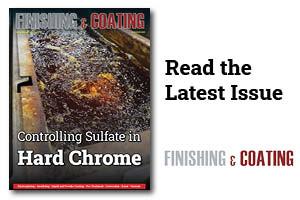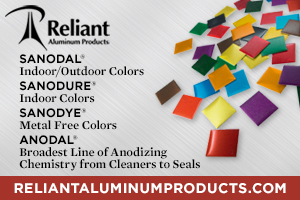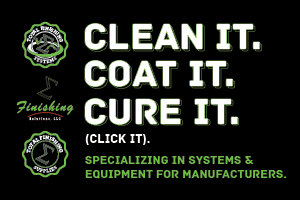It should be plain to acknowledge that corrosion prevention is the main driving force in the metal finishing industry.
 Stephen RudyWe can assume with confidence that identifying, preventing, and combating corrosion are paramount to what we do. Sophisticated finishes are developed and specified for many industries, depending on what we can provide. These include medical, aerospace, military, engineering, consumer, construction, energy, and a host of others. Application requirements such as thickness, color, appearance, ductility, deposit consistency, post-dips (along with others), all mesh to improve field performance and minimize corrosion. Only through the development and use of quality coatings can this be achieved.
Stephen RudyWe can assume with confidence that identifying, preventing, and combating corrosion are paramount to what we do. Sophisticated finishes are developed and specified for many industries, depending on what we can provide. These include medical, aerospace, military, engineering, consumer, construction, energy, and a host of others. Application requirements such as thickness, color, appearance, ductility, deposit consistency, post-dips (along with others), all mesh to improve field performance and minimize corrosion. Only through the development and use of quality coatings can this be achieved.
Why is what we do so important to industries and our nation’s infrastructure? A quantitative value will usually suffice to attract attention. In this respect, National Association of Corrosion Engineers recently stated that the direct costs to our nation of corrosion are estimated to be $276 billion/year, or equivalent to 3.1% of US GDP. Globally, the estimated cost of corrosion is $2.5 trillion, equivalent to 3.4% of global GDP.
The US annual cost of corrosion prevention ranges $357 billion $875 billion. Where does the metal finishing industry fit in to address corrosion? In a basic sense, corrosion defines the wearing away of metals, mainly through oxidation. Corrosion produces, through chemical reactions, byproducts, such as rust. This leads to breakdown and failure of finished parts, typically assembled in critical portions of operating devices, equipment, infrastructure, and other items or materials. Due to the progressive development of products and processes, modernization leads to improvements in how we live, work, travel, and play.
This, in turn, demands substantial upgrades in field performance and exposure of these related items that enable progress. Add to this the importance of environmental stewardship, and we can clarify the role of metal finishing to continually combat and minimize corrosion. Let us check into how different steps in any given process can be critical to quality finishing in terms of corrosion prevention.
Raw Material Stock and Manufactured Parts
Metal finishers can only produce quality coatings if the incoming base materials exhibit the required surface characteristics. As examples, I can relate to many such instances, covering different reasons for inferior incoming quality. To save money, a metal stamper purchased cheaper coil stock. The poor surface quality and excessive carbon smuts gave the plater fits until the problem was addressed and corrected by the stamper.
In another instance, incoming aluminum sheets were purchased through a different supplier. The stock was stored outdoors until ready to be fabricated and plated. Nothing could be done to correct plating blisters. Not even replacing process baths. The problem was found to be the paraffin paper sandwiched between each layer of the aluminum sheet. In the hot sun, the paraffin softened and transposed onto the aluminum sheets. The surface preparation cycle could not remove this film. Eliminating the paraffin paper corrected the problem.
A different problem was related to fabricating a steel coil into parts that were nickel & chrome-plated. Unfortunately, the brightness and leveling characteristics of the nickel deposit suddenly dropped off badly. Analysis of the nickel bath and plating tests confirmed this was not the problem. Neither was there an electrical nor a mechanical problem. Inspection of the incoming coil found it to be to the customer’s specifications, with one side bright and the other side satin. The bright side should be formed as the exterior and the satin side as the interior. The coil was mounted in the stamping machine in reverse, causing the finishing problem.
In a different application, wire goods were inspected after plating and found to exhibit numerous microcracks. It was believed that aggressive surface preparation was causing this problem. It was not, but only aggravated an existing issue at the manufacturing site. The wire was being poorly extruded, resulting in microcracking. Correcting the problem improved the quality of the extruded wire.
Process oils can be very important. Without consulting anyone, a purchasing agent, considering the price, switched from a mineral oil to a chlorinated paraffin. The plater could not remove the new oil from his cleaners, which were satisfactory for the mineral oils. Working with the supplier, they changed cleaners to satisfactorily remove the chlorinated paraffin.
These are some varied examples of how the condition of parts and the coating on them can be very important to quality finishing as it relates to minimizing corrosion. Equipment, old and new, can also be critical to the finishing cycle.
Equipment Considerations
A unique problem occurred as soon as a brand new automatic plating line was installed and began operation. This multi-million-dollar line only produced non-plated parts. Chemically, all process baths were found to be at optimum. The bussing from the rectifier to the plating tank was connected in reverse. It took a few minutes to correct the bus connections.
At another installation, a highly anticipated trivalent chromium alternative to hexavalent chrome plating was being installed. Part of the start-up consisted of dummy electrolysis to condition the electrolyte. Upon test plating, the chrome deposit was pewter in appearance, unlike the blue-white color it was supposed to be. It was found to be another incidence of reverse bussing to the plating tank rectifier. Unfortunately, the new bath was so grossly contaminated with metallic contamination, it had to be replaced with a new one. This resulted in plating the desired chrome deposit.
Carbon filtration is crucial for maintaining the clarity of plating solutions and removing organic contaminants. If the equipment is not properly serviced or used, the benefits of proper filtration will not be achieved. I have experienced many situations where filtration equipment was inoperable due to broken or worn parts. A lack of filtration can result in dull plating, roughness, and poor ductility. Sometimes the obvious corrective approach is bypassed in favor of adding more brighteners or other additives to the plating bath. This, in turn, exacerbates or worsens the plating condition.
There have also been problems related to inadequate equipment maintenance. How can a trickle filter return possibly benefit the purification turnover of a 1,000-gallon nickel bath?
Rectifiers can be considered the nerve center of the plating application. Without current, the parts don’t get plated. Without proper current, the parts will not be plated to the required specification. Rectifiers need to be serviced regularly by capable personnel. If not, the obvious problems will occur.
One very expensive problem comes to mind. The decorative chrome deposit was hazy and white washed. The bath analysis was in range. All other baths and rinses were also in good order. The wrong approach occurred when sulfuric acid and barium carbonate additions were made. Next, panic stepped in as rinses were dumped and the chrome bath was replaced with a new makeup, all to no avail. Finally, someone mentioned the rectifier. A call was placed to the manufacturer. Within five minutes, the serviceman accurately diagnosed the problem with his oscilloscope: AC ripple.
If corrosion is minimized and the quality service life of parts improved, attention to every portion of the finishing process must be in focus. The examples given highlight problems and failures that adversely affected the condition of the incoming and finished parts. Some instances were obvious, while others were more complicated, requiring intuition and patience. In itself, corrosion is a major challenge to progress. Whatever can be properly done in the metal finishing process should, by all intents, contribute to achieving the targeted service life and avoid the tendency of early corrosion problems. That is why the metal finishing industry is so important to all facets of global manufacturing and the end use of assembled parts.
Stephen F. Rudy, CEF, is president of Chem Analytic and has written extensively about the finishing industry. Visit www.chemanalytic.com or call him at 917-604-5001.



































